Healthcare and Social Determinants for Indigenous Australians
VerifiedAdded on 2023/01/19
|12
|2891
|41
Essay
AI Summary
This essay addresses the crucial relationship between housing and healthcare for Indigenous Australians, particularly in the Northern Territory. It highlights the government's consideration of providing housing to this group and the impact of social determinants of health (SDOH). The essay explores the background of the issue, the high rates of homelessness and overcrowded housing, and the social determinants that negatively affect the health of Indigenous populations. These determinants include racism, housing conditions, and stress. The essay emphasizes the link between SDOH and health inequalities and provides recommendations for policy improvements, such as working with families, linking them with human services, promoting quality primary care, and ensuring housing as a human right. The essay concludes by recommending the implementation of housing policies and educational and employment opportunities, devoid of racial discrimination to improve the standard of living for Indigenous Australians.
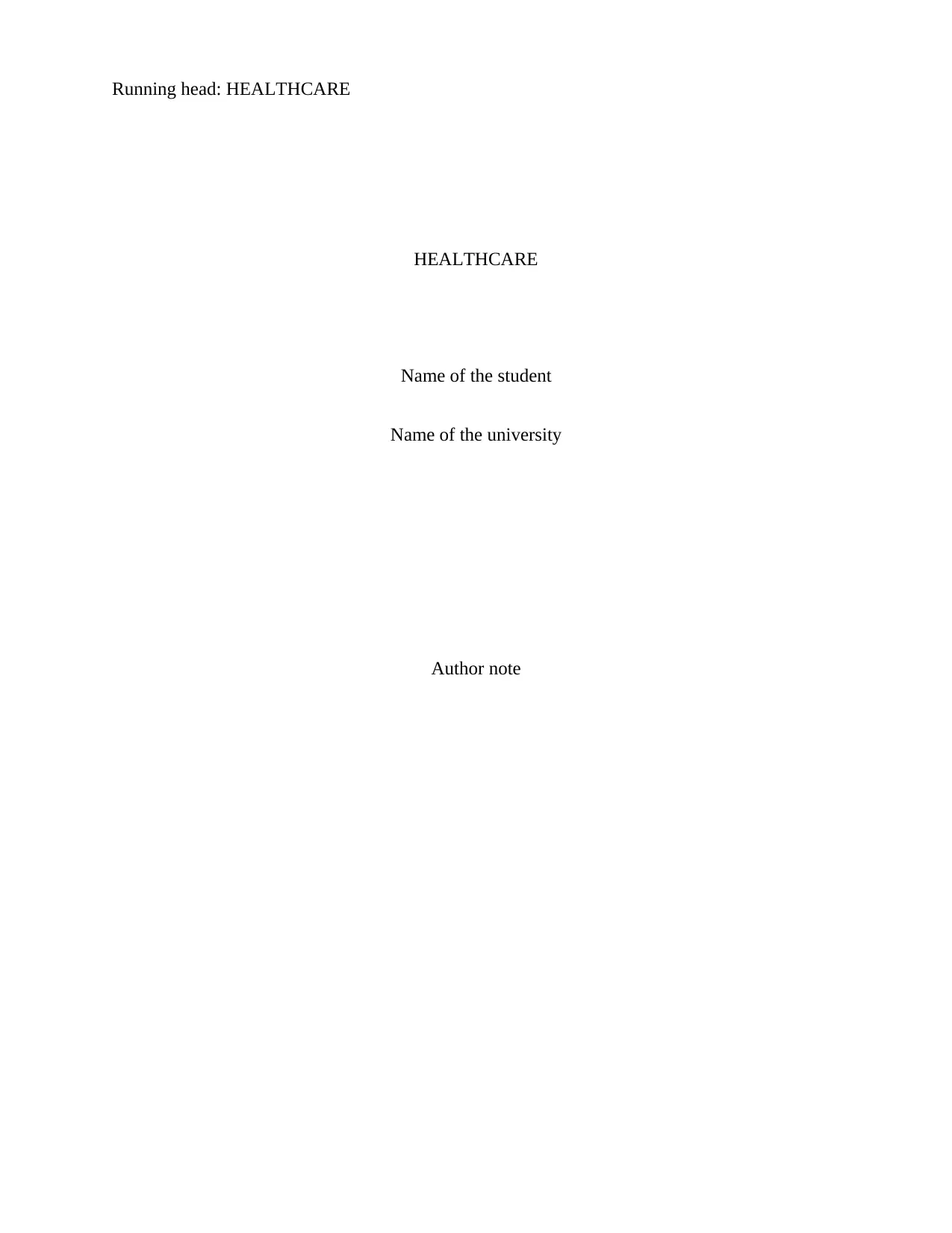
Running head: HEALTHCARE
HEALTHCARE
Name of the student
Name of the university
Author note
HEALTHCARE
Name of the student
Name of the university
Author note
Paraphrase This Document
Need a fresh take? Get an instant paraphrase of this document with our AI Paraphraser
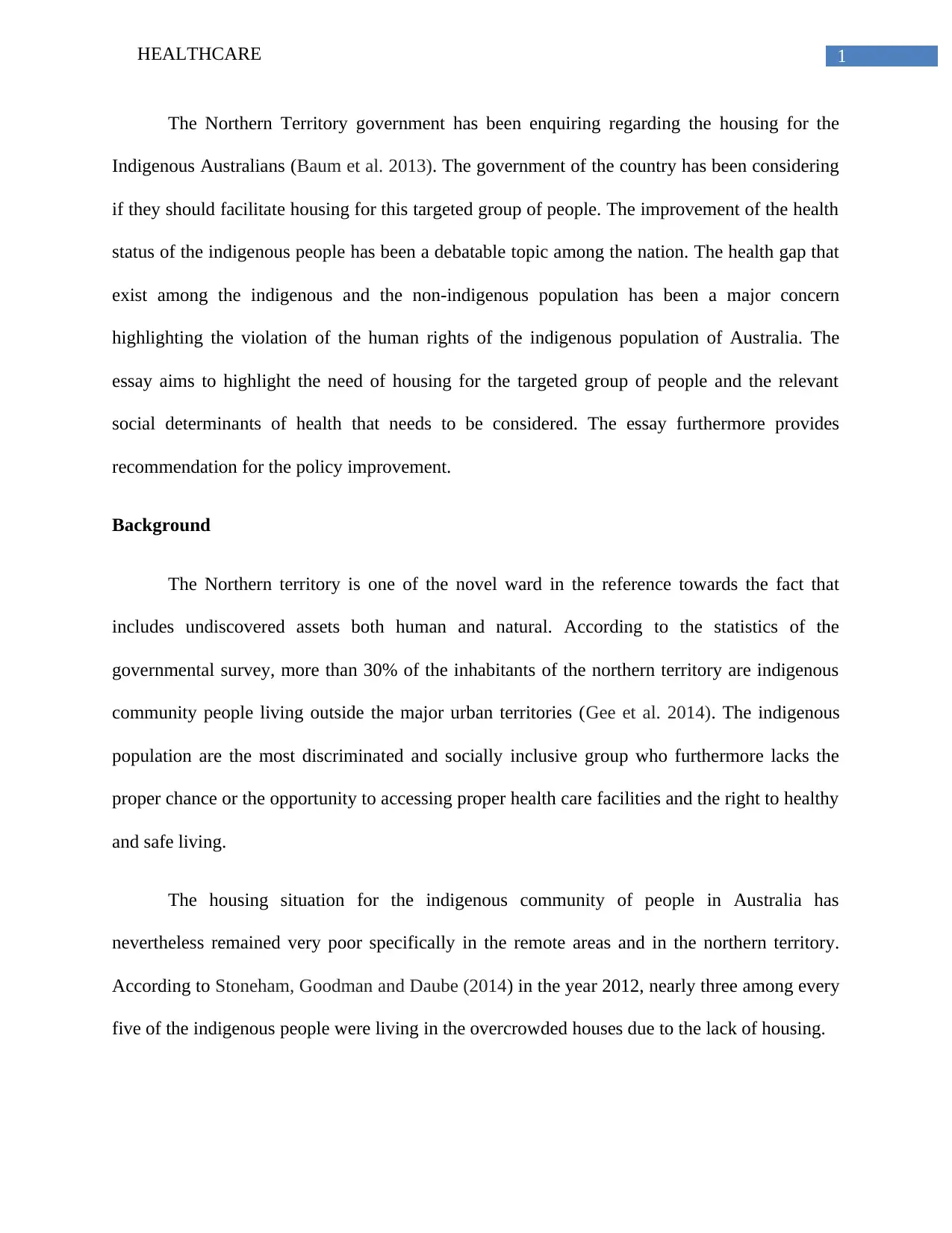
1HEALTHCARE
The Northern Territory government has been enquiring regarding the housing for the
Indigenous Australians (Baum et al. 2013). The government of the country has been considering
if they should facilitate housing for this targeted group of people. The improvement of the health
status of the indigenous people has been a debatable topic among the nation. The health gap that
exist among the indigenous and the non-indigenous population has been a major concern
highlighting the violation of the human rights of the indigenous population of Australia. The
essay aims to highlight the need of housing for the targeted group of people and the relevant
social determinants of health that needs to be considered. The essay furthermore provides
recommendation for the policy improvement.
Background
The Northern territory is one of the novel ward in the reference towards the fact that
includes undiscovered assets both human and natural. According to the statistics of the
governmental survey, more than 30% of the inhabitants of the northern territory are indigenous
community people living outside the major urban territories (Gee et al. 2014). The indigenous
population are the most discriminated and socially inclusive group who furthermore lacks the
proper chance or the opportunity to accessing proper health care facilities and the right to healthy
and safe living.
The housing situation for the indigenous community of people in Australia has
nevertheless remained very poor specifically in the remote areas and in the northern territory.
According to Stoneham, Goodman and Daube (2014) in the year 2012, nearly three among every
five of the indigenous people were living in the overcrowded houses due to the lack of housing.
The Northern Territory government has been enquiring regarding the housing for the
Indigenous Australians (Baum et al. 2013). The government of the country has been considering
if they should facilitate housing for this targeted group of people. The improvement of the health
status of the indigenous people has been a debatable topic among the nation. The health gap that
exist among the indigenous and the non-indigenous population has been a major concern
highlighting the violation of the human rights of the indigenous population of Australia. The
essay aims to highlight the need of housing for the targeted group of people and the relevant
social determinants of health that needs to be considered. The essay furthermore provides
recommendation for the policy improvement.
Background
The Northern territory is one of the novel ward in the reference towards the fact that
includes undiscovered assets both human and natural. According to the statistics of the
governmental survey, more than 30% of the inhabitants of the northern territory are indigenous
community people living outside the major urban territories (Gee et al. 2014). The indigenous
population are the most discriminated and socially inclusive group who furthermore lacks the
proper chance or the opportunity to accessing proper health care facilities and the right to healthy
and safe living.
The housing situation for the indigenous community of people in Australia has
nevertheless remained very poor specifically in the remote areas and in the northern territory.
According to Stoneham, Goodman and Daube (2014) in the year 2012, nearly three among every
five of the indigenous people were living in the overcrowded houses due to the lack of housing.
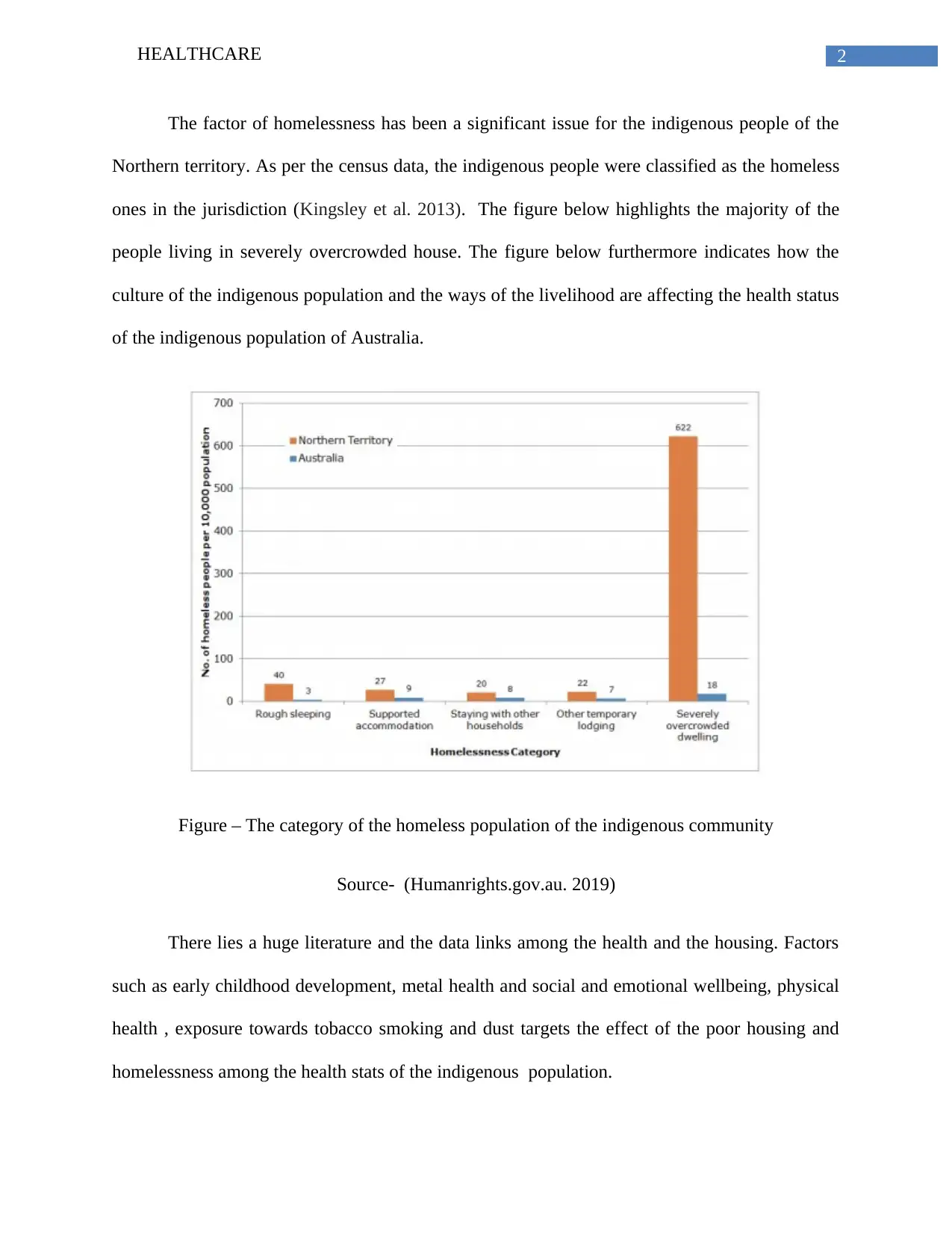
2HEALTHCARE
The factor of homelessness has been a significant issue for the indigenous people of the
Northern territory. As per the census data, the indigenous people were classified as the homeless
ones in the jurisdiction (Kingsley et al. 2013). The figure below highlights the majority of the
people living in severely overcrowded house. The figure below furthermore indicates how the
culture of the indigenous population and the ways of the livelihood are affecting the health status
of the indigenous population of Australia.
Figure – The category of the homeless population of the indigenous community
Source- (Humanrights.gov.au. 2019)
There lies a huge literature and the data links among the health and the housing. Factors
such as early childhood development, metal health and social and emotional wellbeing, physical
health , exposure towards tobacco smoking and dust targets the effect of the poor housing and
homelessness among the health stats of the indigenous population.
The factor of homelessness has been a significant issue for the indigenous people of the
Northern territory. As per the census data, the indigenous people were classified as the homeless
ones in the jurisdiction (Kingsley et al. 2013). The figure below highlights the majority of the
people living in severely overcrowded house. The figure below furthermore indicates how the
culture of the indigenous population and the ways of the livelihood are affecting the health status
of the indigenous population of Australia.
Figure – The category of the homeless population of the indigenous community
Source- (Humanrights.gov.au. 2019)
There lies a huge literature and the data links among the health and the housing. Factors
such as early childhood development, metal health and social and emotional wellbeing, physical
health , exposure towards tobacco smoking and dust targets the effect of the poor housing and
homelessness among the health stats of the indigenous population.
⊘ This is a preview!⊘
Do you want full access?
Subscribe today to unlock all pages.

Trusted by 1+ million students worldwide
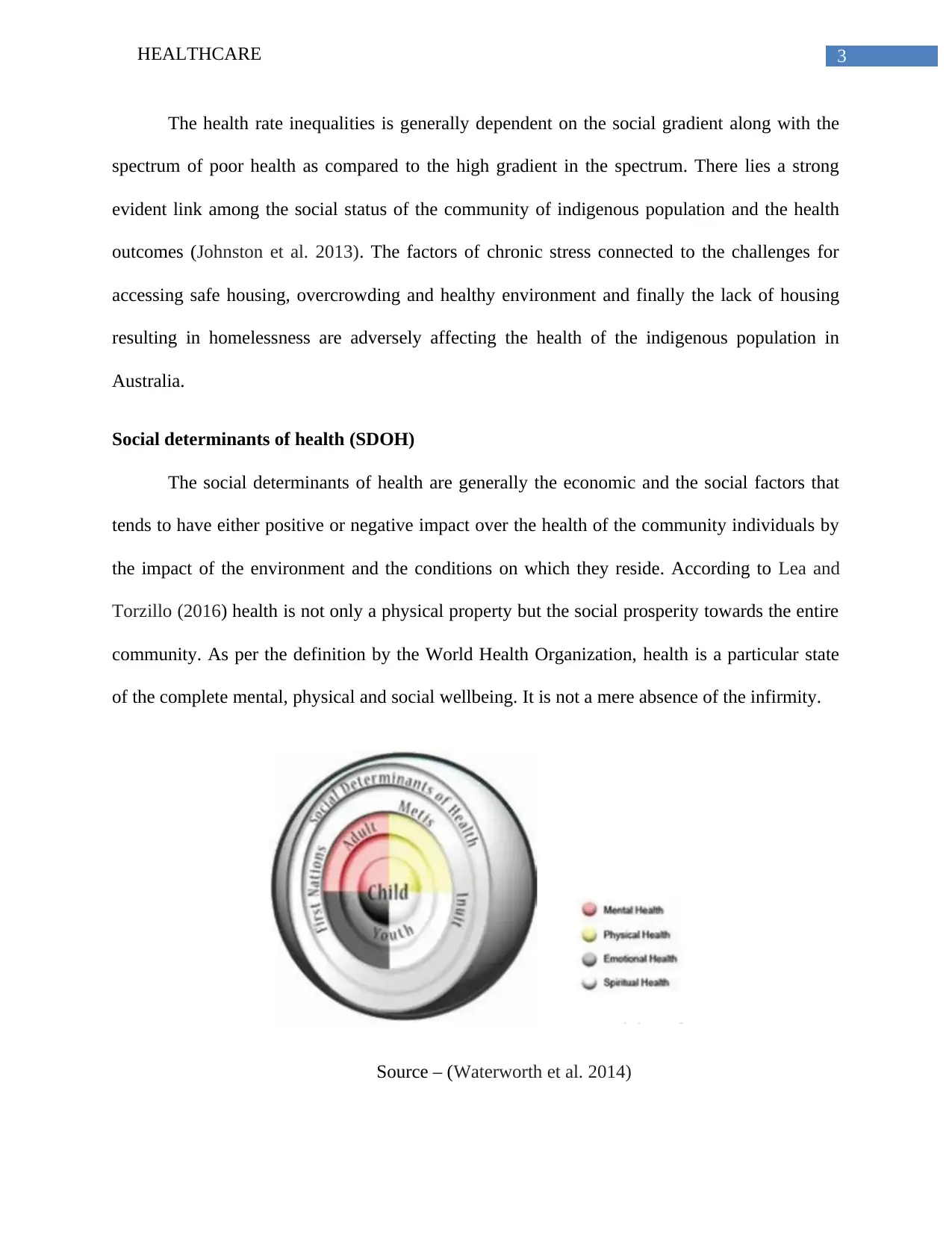
3HEALTHCARE
The health rate inequalities is generally dependent on the social gradient along with the
spectrum of poor health as compared to the high gradient in the spectrum. There lies a strong
evident link among the social status of the community of indigenous population and the health
outcomes (Johnston et al. 2013). The factors of chronic stress connected to the challenges for
accessing safe housing, overcrowding and healthy environment and finally the lack of housing
resulting in homelessness are adversely affecting the health of the indigenous population in
Australia.
Social determinants of health (SDOH)
The social determinants of health are generally the economic and the social factors that
tends to have either positive or negative impact over the health of the community individuals by
the impact of the environment and the conditions on which they reside. According to Lea and
Torzillo (2016) health is not only a physical property but the social prosperity towards the entire
community. As per the definition by the World Health Organization, health is a particular state
of the complete mental, physical and social wellbeing. It is not a mere absence of the infirmity.
Source – (Waterworth et al. 2014)
The health rate inequalities is generally dependent on the social gradient along with the
spectrum of poor health as compared to the high gradient in the spectrum. There lies a strong
evident link among the social status of the community of indigenous population and the health
outcomes (Johnston et al. 2013). The factors of chronic stress connected to the challenges for
accessing safe housing, overcrowding and healthy environment and finally the lack of housing
resulting in homelessness are adversely affecting the health of the indigenous population in
Australia.
Social determinants of health (SDOH)
The social determinants of health are generally the economic and the social factors that
tends to have either positive or negative impact over the health of the community individuals by
the impact of the environment and the conditions on which they reside. According to Lea and
Torzillo (2016) health is not only a physical property but the social prosperity towards the entire
community. As per the definition by the World Health Organization, health is a particular state
of the complete mental, physical and social wellbeing. It is not a mere absence of the infirmity.
Source – (Waterworth et al. 2014)
Paraphrase This Document
Need a fresh take? Get an instant paraphrase of this document with our AI Paraphraser
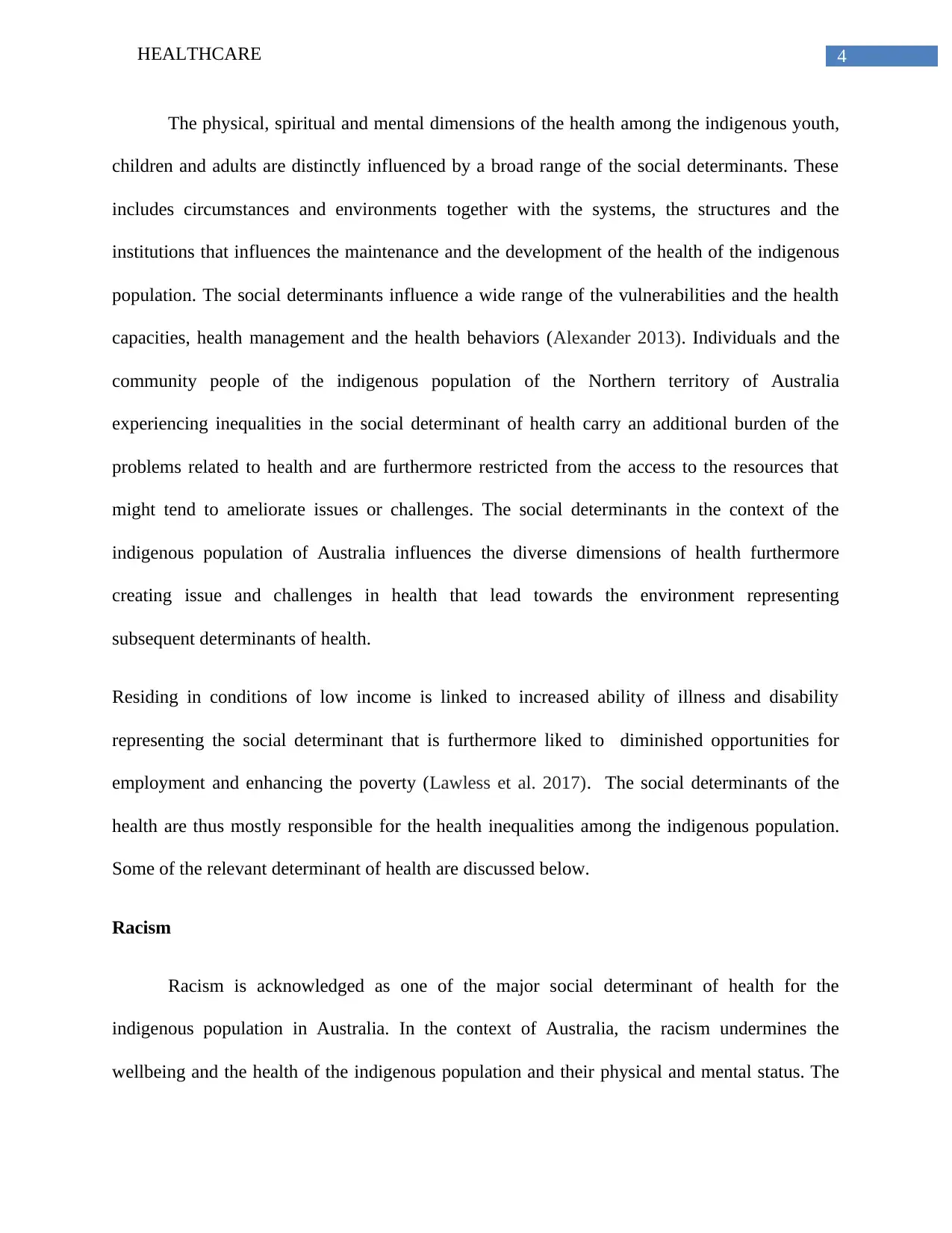
4HEALTHCARE
The physical, spiritual and mental dimensions of the health among the indigenous youth,
children and adults are distinctly influenced by a broad range of the social determinants. These
includes circumstances and environments together with the systems, the structures and the
institutions that influences the maintenance and the development of the health of the indigenous
population. The social determinants influence a wide range of the vulnerabilities and the health
capacities, health management and the health behaviors (Alexander 2013). Individuals and the
community people of the indigenous population of the Northern territory of Australia
experiencing inequalities in the social determinant of health carry an additional burden of the
problems related to health and are furthermore restricted from the access to the resources that
might tend to ameliorate issues or challenges. The social determinants in the context of the
indigenous population of Australia influences the diverse dimensions of health furthermore
creating issue and challenges in health that lead towards the environment representing
subsequent determinants of health.
Residing in conditions of low income is linked to increased ability of illness and disability
representing the social determinant that is furthermore liked to diminished opportunities for
employment and enhancing the poverty (Lawless et al. 2017). The social determinants of the
health are thus mostly responsible for the health inequalities among the indigenous population.
Some of the relevant determinant of health are discussed below.
Racism
Racism is acknowledged as one of the major social determinant of health for the
indigenous population in Australia. In the context of Australia, the racism undermines the
wellbeing and the health of the indigenous population and their physical and mental status. The
The physical, spiritual and mental dimensions of the health among the indigenous youth,
children and adults are distinctly influenced by a broad range of the social determinants. These
includes circumstances and environments together with the systems, the structures and the
institutions that influences the maintenance and the development of the health of the indigenous
population. The social determinants influence a wide range of the vulnerabilities and the health
capacities, health management and the health behaviors (Alexander 2013). Individuals and the
community people of the indigenous population of the Northern territory of Australia
experiencing inequalities in the social determinant of health carry an additional burden of the
problems related to health and are furthermore restricted from the access to the resources that
might tend to ameliorate issues or challenges. The social determinants in the context of the
indigenous population of Australia influences the diverse dimensions of health furthermore
creating issue and challenges in health that lead towards the environment representing
subsequent determinants of health.
Residing in conditions of low income is linked to increased ability of illness and disability
representing the social determinant that is furthermore liked to diminished opportunities for
employment and enhancing the poverty (Lawless et al. 2017). The social determinants of the
health are thus mostly responsible for the health inequalities among the indigenous population.
Some of the relevant determinant of health are discussed below.
Racism
Racism is acknowledged as one of the major social determinant of health for the
indigenous population in Australia. In the context of Australia, the racism undermines the
wellbeing and the health of the indigenous population and their physical and mental status. The
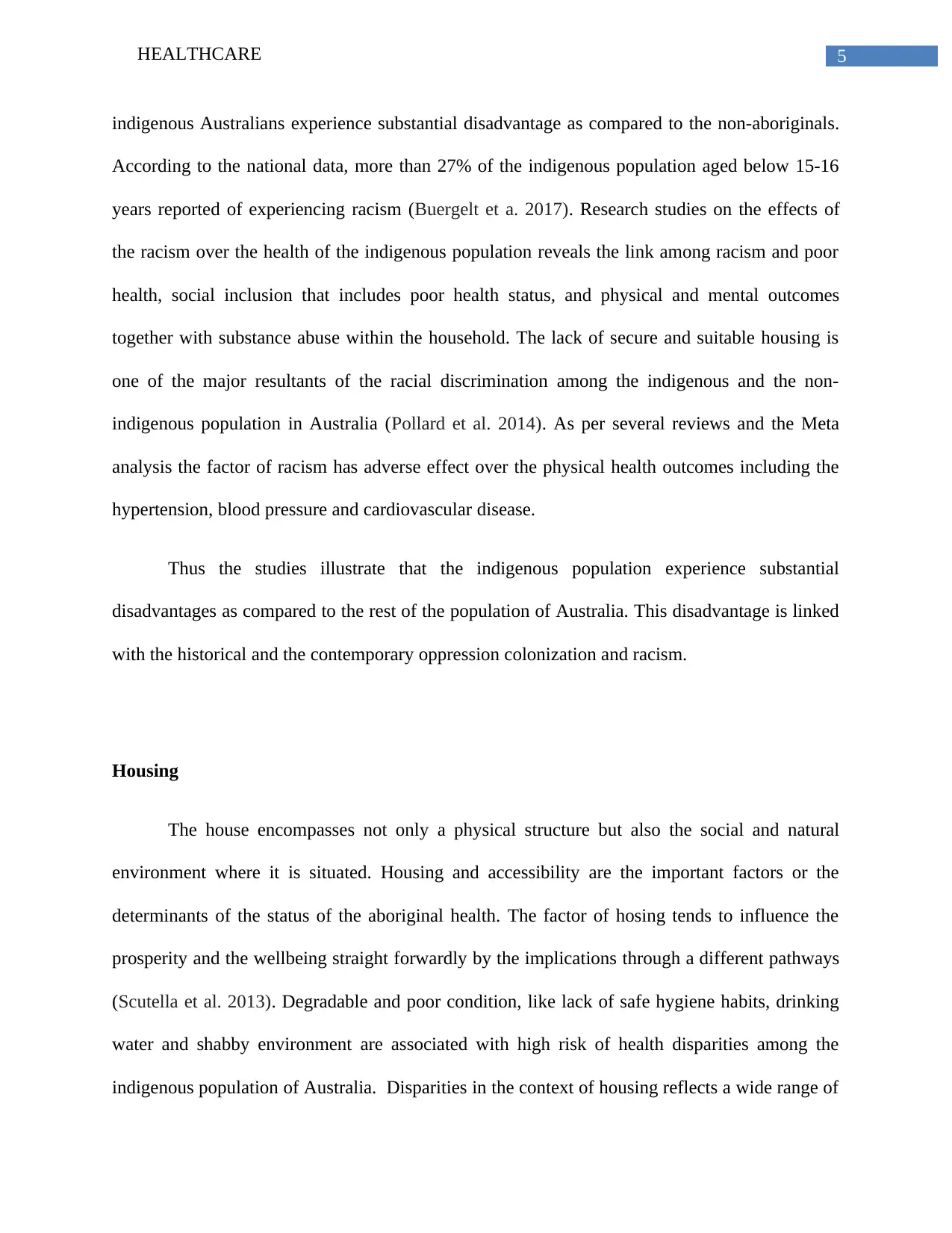
5HEALTHCARE
indigenous Australians experience substantial disadvantage as compared to the non-aboriginals.
According to the national data, more than 27% of the indigenous population aged below 15-16
years reported of experiencing racism (Buergelt et a. 2017). Research studies on the effects of
the racism over the health of the indigenous population reveals the link among racism and poor
health, social inclusion that includes poor health status, and physical and mental outcomes
together with substance abuse within the household. The lack of secure and suitable housing is
one of the major resultants of the racial discrimination among the indigenous and the non-
indigenous population in Australia (Pollard et al. 2014). As per several reviews and the Meta
analysis the factor of racism has adverse effect over the physical health outcomes including the
hypertension, blood pressure and cardiovascular disease.
Thus the studies illustrate that the indigenous population experience substantial
disadvantages as compared to the rest of the population of Australia. This disadvantage is linked
with the historical and the contemporary oppression colonization and racism.
Housing
The house encompasses not only a physical structure but also the social and natural
environment where it is situated. Housing and accessibility are the important factors or the
determinants of the status of the aboriginal health. The factor of hosing tends to influence the
prosperity and the wellbeing straight forwardly by the implications through a different pathways
(Scutella et al. 2013). Degradable and poor condition, like lack of safe hygiene habits, drinking
water and shabby environment are associated with high risk of health disparities among the
indigenous population of Australia. Disparities in the context of housing reflects a wide range of
indigenous Australians experience substantial disadvantage as compared to the non-aboriginals.
According to the national data, more than 27% of the indigenous population aged below 15-16
years reported of experiencing racism (Buergelt et a. 2017). Research studies on the effects of
the racism over the health of the indigenous population reveals the link among racism and poor
health, social inclusion that includes poor health status, and physical and mental outcomes
together with substance abuse within the household. The lack of secure and suitable housing is
one of the major resultants of the racial discrimination among the indigenous and the non-
indigenous population in Australia (Pollard et al. 2014). As per several reviews and the Meta
analysis the factor of racism has adverse effect over the physical health outcomes including the
hypertension, blood pressure and cardiovascular disease.
Thus the studies illustrate that the indigenous population experience substantial
disadvantages as compared to the rest of the population of Australia. This disadvantage is linked
with the historical and the contemporary oppression colonization and racism.
Housing
The house encompasses not only a physical structure but also the social and natural
environment where it is situated. Housing and accessibility are the important factors or the
determinants of the status of the aboriginal health. The factor of hosing tends to influence the
prosperity and the wellbeing straight forwardly by the implications through a different pathways
(Scutella et al. 2013). Degradable and poor condition, like lack of safe hygiene habits, drinking
water and shabby environment are associated with high risk of health disparities among the
indigenous population of Australia. Disparities in the context of housing reflects a wide range of
⊘ This is a preview!⊘
Do you want full access?
Subscribe today to unlock all pages.

Trusted by 1+ million students worldwide
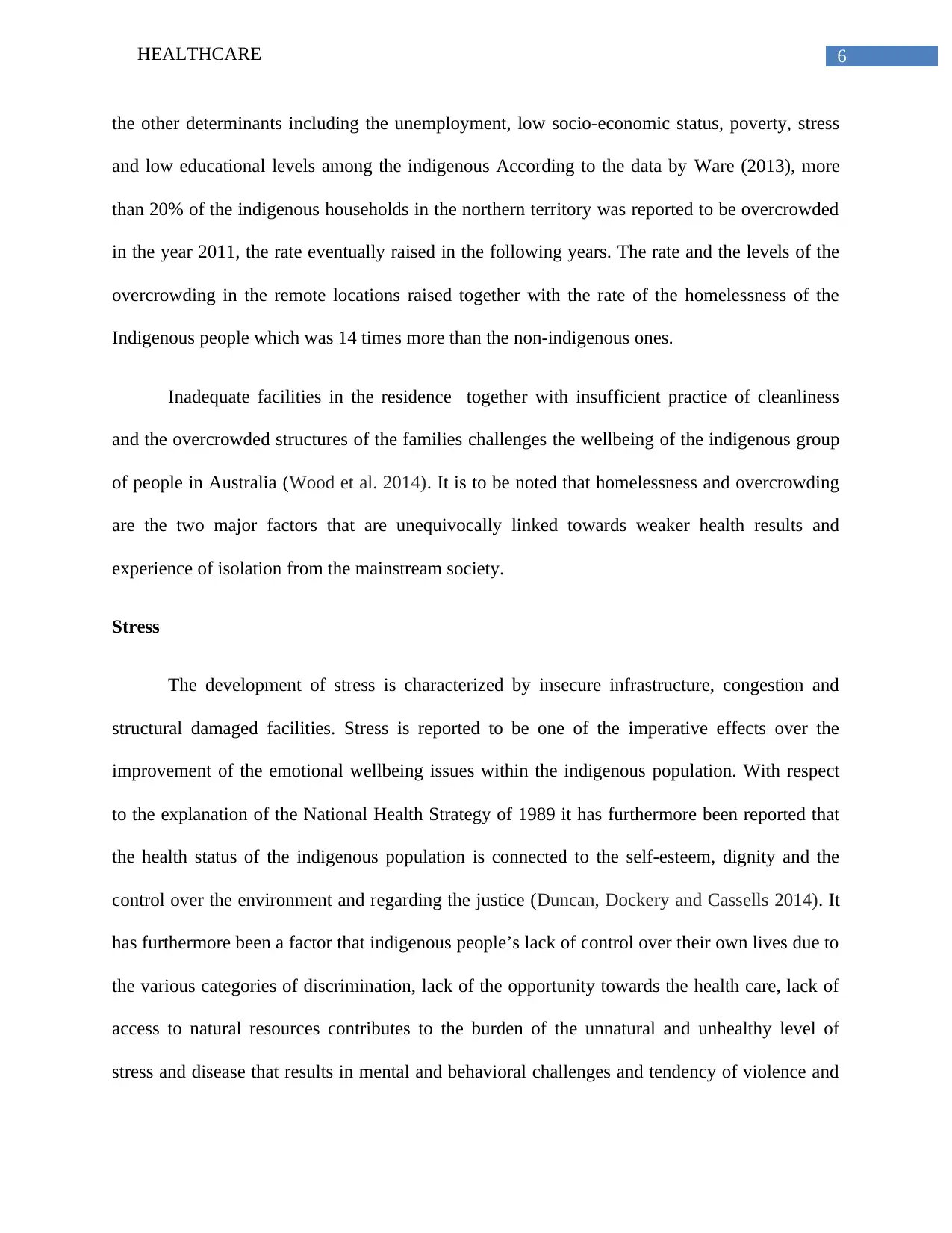
6HEALTHCARE
the other determinants including the unemployment, low socio-economic status, poverty, stress
and low educational levels among the indigenous According to the data by Ware (2013), more
than 20% of the indigenous households in the northern territory was reported to be overcrowded
in the year 2011, the rate eventually raised in the following years. The rate and the levels of the
overcrowding in the remote locations raised together with the rate of the homelessness of the
Indigenous people which was 14 times more than the non-indigenous ones.
Inadequate facilities in the residence together with insufficient practice of cleanliness
and the overcrowded structures of the families challenges the wellbeing of the indigenous group
of people in Australia (Wood et al. 2014). It is to be noted that homelessness and overcrowding
are the two major factors that are unequivocally linked towards weaker health results and
experience of isolation from the mainstream society.
Stress
The development of stress is characterized by insecure infrastructure, congestion and
structural damaged facilities. Stress is reported to be one of the imperative effects over the
improvement of the emotional wellbeing issues within the indigenous population. With respect
to the explanation of the National Health Strategy of 1989 it has furthermore been reported that
the health status of the indigenous population is connected to the self-esteem, dignity and the
control over the environment and regarding the justice (Duncan, Dockery and Cassells 2014). It
has furthermore been a factor that indigenous people’s lack of control over their own lives due to
the various categories of discrimination, lack of the opportunity towards the health care, lack of
access to natural resources contributes to the burden of the unnatural and unhealthy level of
stress and disease that results in mental and behavioral challenges and tendency of violence and
the other determinants including the unemployment, low socio-economic status, poverty, stress
and low educational levels among the indigenous According to the data by Ware (2013), more
than 20% of the indigenous households in the northern territory was reported to be overcrowded
in the year 2011, the rate eventually raised in the following years. The rate and the levels of the
overcrowding in the remote locations raised together with the rate of the homelessness of the
Indigenous people which was 14 times more than the non-indigenous ones.
Inadequate facilities in the residence together with insufficient practice of cleanliness
and the overcrowded structures of the families challenges the wellbeing of the indigenous group
of people in Australia (Wood et al. 2014). It is to be noted that homelessness and overcrowding
are the two major factors that are unequivocally linked towards weaker health results and
experience of isolation from the mainstream society.
Stress
The development of stress is characterized by insecure infrastructure, congestion and
structural damaged facilities. Stress is reported to be one of the imperative effects over the
improvement of the emotional wellbeing issues within the indigenous population. With respect
to the explanation of the National Health Strategy of 1989 it has furthermore been reported that
the health status of the indigenous population is connected to the self-esteem, dignity and the
control over the environment and regarding the justice (Duncan, Dockery and Cassells 2014). It
has furthermore been a factor that indigenous people’s lack of control over their own lives due to
the various categories of discrimination, lack of the opportunity towards the health care, lack of
access to natural resources contributes to the burden of the unnatural and unhealthy level of
stress and disease that results in mental and behavioral challenges and tendency of violence and
Paraphrase This Document
Need a fresh take? Get an instant paraphrase of this document with our AI Paraphraser
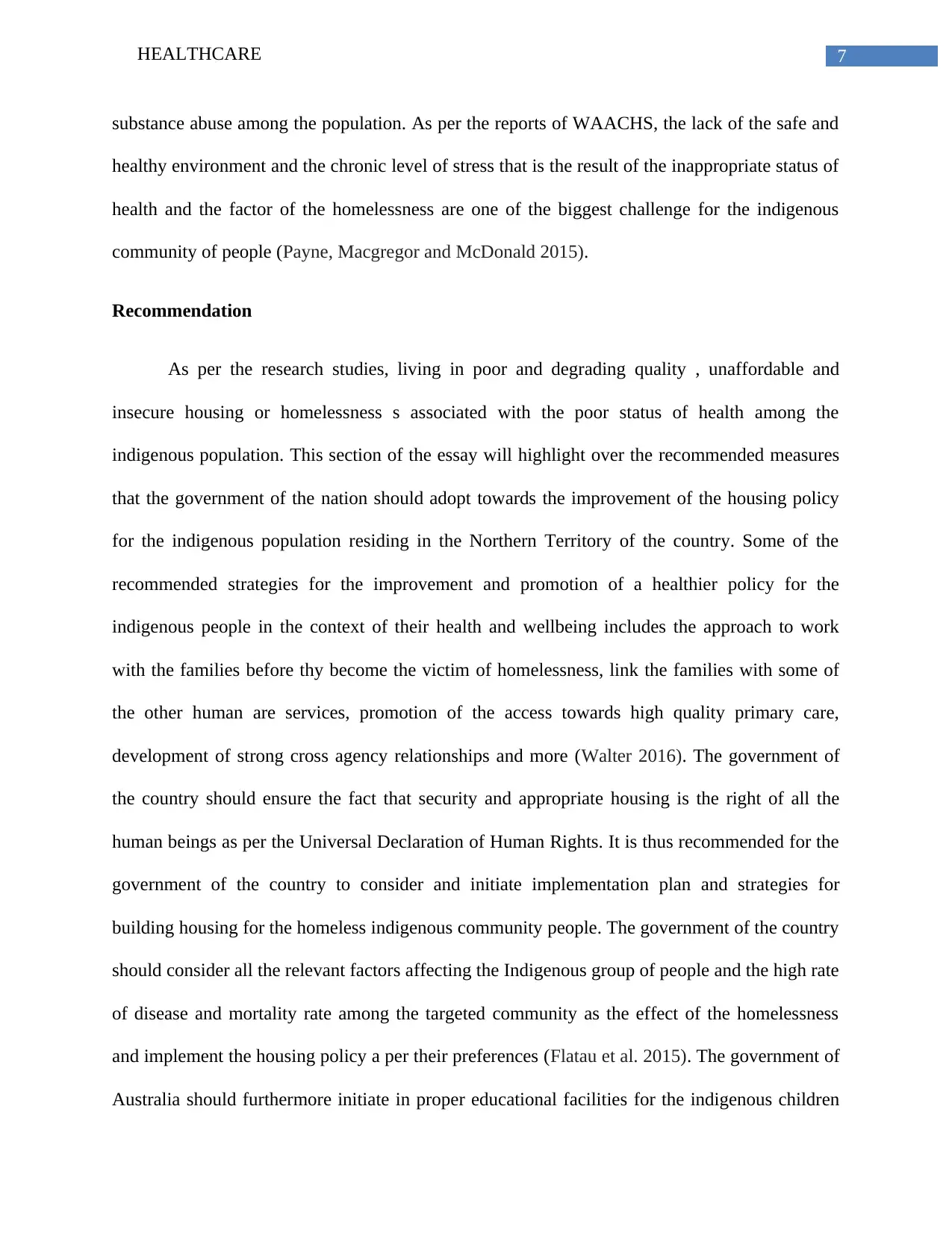
7HEALTHCARE
substance abuse among the population. As per the reports of WAACHS, the lack of the safe and
healthy environment and the chronic level of stress that is the result of the inappropriate status of
health and the factor of the homelessness are one of the biggest challenge for the indigenous
community of people (Payne, Macgregor and McDonald 2015).
Recommendation
As per the research studies, living in poor and degrading quality , unaffordable and
insecure housing or homelessness s associated with the poor status of health among the
indigenous population. This section of the essay will highlight over the recommended measures
that the government of the nation should adopt towards the improvement of the housing policy
for the indigenous population residing in the Northern Territory of the country. Some of the
recommended strategies for the improvement and promotion of a healthier policy for the
indigenous people in the context of their health and wellbeing includes the approach to work
with the families before thy become the victim of homelessness, link the families with some of
the other human are services, promotion of the access towards high quality primary care,
development of strong cross agency relationships and more (Walter 2016). The government of
the country should ensure the fact that security and appropriate housing is the right of all the
human beings as per the Universal Declaration of Human Rights. It is thus recommended for the
government of the country to consider and initiate implementation plan and strategies for
building housing for the homeless indigenous community people. The government of the country
should consider all the relevant factors affecting the Indigenous group of people and the high rate
of disease and mortality rate among the targeted community as the effect of the homelessness
and implement the housing policy a per their preferences (Flatau et al. 2015). The government of
Australia should furthermore initiate in proper educational facilities for the indigenous children
substance abuse among the population. As per the reports of WAACHS, the lack of the safe and
healthy environment and the chronic level of stress that is the result of the inappropriate status of
health and the factor of the homelessness are one of the biggest challenge for the indigenous
community of people (Payne, Macgregor and McDonald 2015).
Recommendation
As per the research studies, living in poor and degrading quality , unaffordable and
insecure housing or homelessness s associated with the poor status of health among the
indigenous population. This section of the essay will highlight over the recommended measures
that the government of the nation should adopt towards the improvement of the housing policy
for the indigenous population residing in the Northern Territory of the country. Some of the
recommended strategies for the improvement and promotion of a healthier policy for the
indigenous people in the context of their health and wellbeing includes the approach to work
with the families before thy become the victim of homelessness, link the families with some of
the other human are services, promotion of the access towards high quality primary care,
development of strong cross agency relationships and more (Walter 2016). The government of
the country should ensure the fact that security and appropriate housing is the right of all the
human beings as per the Universal Declaration of Human Rights. It is thus recommended for the
government of the country to consider and initiate implementation plan and strategies for
building housing for the homeless indigenous community people. The government of the country
should consider all the relevant factors affecting the Indigenous group of people and the high rate
of disease and mortality rate among the targeted community as the effect of the homelessness
and implement the housing policy a per their preferences (Flatau et al. 2015). The government of
Australia should furthermore initiate in proper educational facilities for the indigenous children
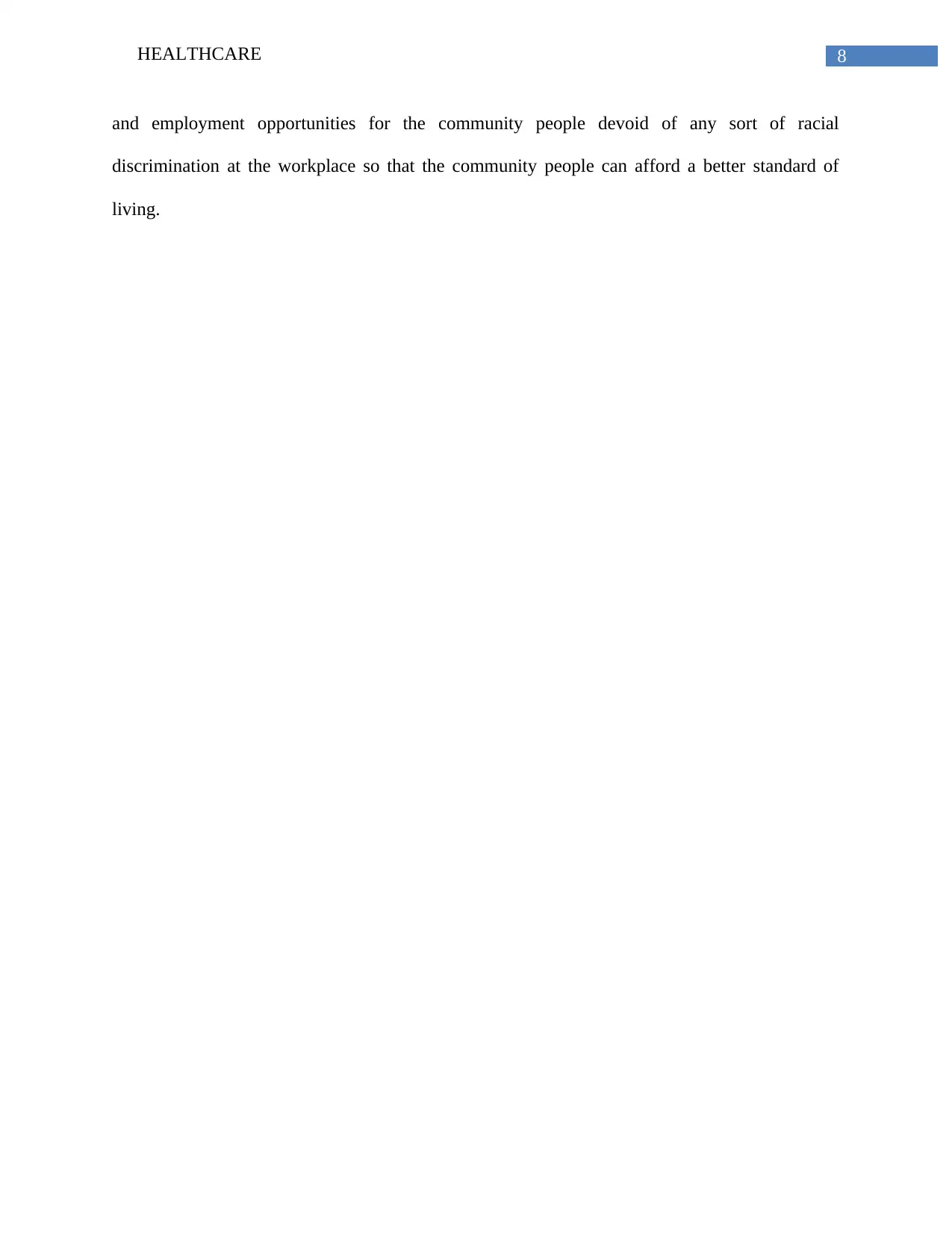
8HEALTHCARE
and employment opportunities for the community people devoid of any sort of racial
discrimination at the workplace so that the community people can afford a better standard of
living.
and employment opportunities for the community people devoid of any sort of racial
discrimination at the workplace so that the community people can afford a better standard of
living.
⊘ This is a preview!⊘
Do you want full access?
Subscribe today to unlock all pages.

Trusted by 1+ million students worldwide
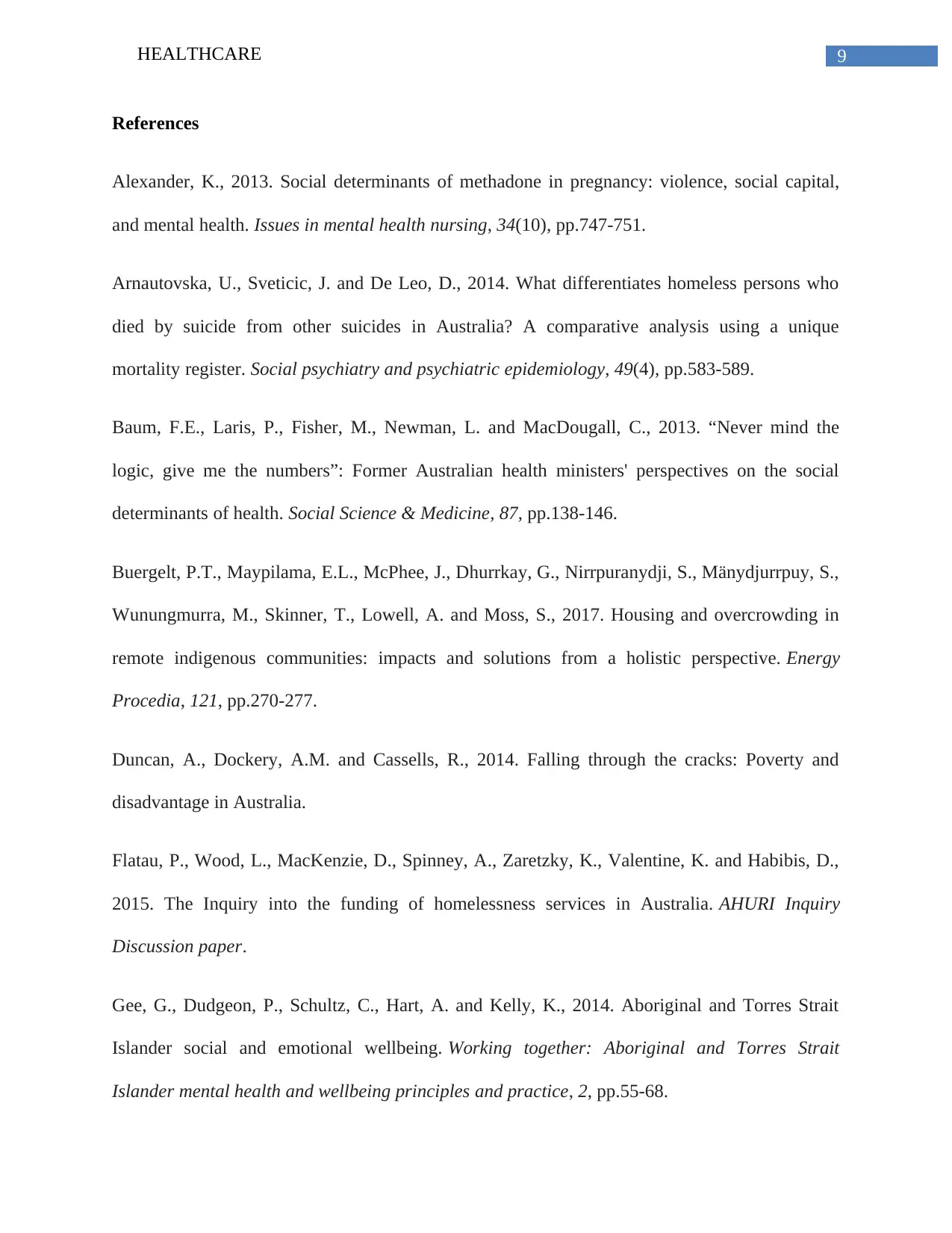
9HEALTHCARE
References
Alexander, K., 2013. Social determinants of methadone in pregnancy: violence, social capital,
and mental health. Issues in mental health nursing, 34(10), pp.747-751.
Arnautovska, U., Sveticic, J. and De Leo, D., 2014. What differentiates homeless persons who
died by suicide from other suicides in Australia? A comparative analysis using a unique
mortality register. Social psychiatry and psychiatric epidemiology, 49(4), pp.583-589.
Baum, F.E., Laris, P., Fisher, M., Newman, L. and MacDougall, C., 2013. “Never mind the
logic, give me the numbers”: Former Australian health ministers' perspectives on the social
determinants of health. Social Science & Medicine, 87, pp.138-146.
Buergelt, P.T., Maypilama, E.L., McPhee, J., Dhurrkay, G., Nirrpuranydji, S., Mänydjurrpuy, S.,
Wunungmurra, M., Skinner, T., Lowell, A. and Moss, S., 2017. Housing and overcrowding in
remote indigenous communities: impacts and solutions from a holistic perspective. Energy
Procedia, 121, pp.270-277.
Duncan, A., Dockery, A.M. and Cassells, R., 2014. Falling through the cracks: Poverty and
disadvantage in Australia.
Flatau, P., Wood, L., MacKenzie, D., Spinney, A., Zaretzky, K., Valentine, K. and Habibis, D.,
2015. The Inquiry into the funding of homelessness services in Australia. AHURI Inquiry
Discussion paper.
Gee, G., Dudgeon, P., Schultz, C., Hart, A. and Kelly, K., 2014. Aboriginal and Torres Strait
Islander social and emotional wellbeing. Working together: Aboriginal and Torres Strait
Islander mental health and wellbeing principles and practice, 2, pp.55-68.
References
Alexander, K., 2013. Social determinants of methadone in pregnancy: violence, social capital,
and mental health. Issues in mental health nursing, 34(10), pp.747-751.
Arnautovska, U., Sveticic, J. and De Leo, D., 2014. What differentiates homeless persons who
died by suicide from other suicides in Australia? A comparative analysis using a unique
mortality register. Social psychiatry and psychiatric epidemiology, 49(4), pp.583-589.
Baum, F.E., Laris, P., Fisher, M., Newman, L. and MacDougall, C., 2013. “Never mind the
logic, give me the numbers”: Former Australian health ministers' perspectives on the social
determinants of health. Social Science & Medicine, 87, pp.138-146.
Buergelt, P.T., Maypilama, E.L., McPhee, J., Dhurrkay, G., Nirrpuranydji, S., Mänydjurrpuy, S.,
Wunungmurra, M., Skinner, T., Lowell, A. and Moss, S., 2017. Housing and overcrowding in
remote indigenous communities: impacts and solutions from a holistic perspective. Energy
Procedia, 121, pp.270-277.
Duncan, A., Dockery, A.M. and Cassells, R., 2014. Falling through the cracks: Poverty and
disadvantage in Australia.
Flatau, P., Wood, L., MacKenzie, D., Spinney, A., Zaretzky, K., Valentine, K. and Habibis, D.,
2015. The Inquiry into the funding of homelessness services in Australia. AHURI Inquiry
Discussion paper.
Gee, G., Dudgeon, P., Schultz, C., Hart, A. and Kelly, K., 2014. Aboriginal and Torres Strait
Islander social and emotional wellbeing. Working together: Aboriginal and Torres Strait
Islander mental health and wellbeing principles and practice, 2, pp.55-68.
Paraphrase This Document
Need a fresh take? Get an instant paraphrase of this document with our AI Paraphraser
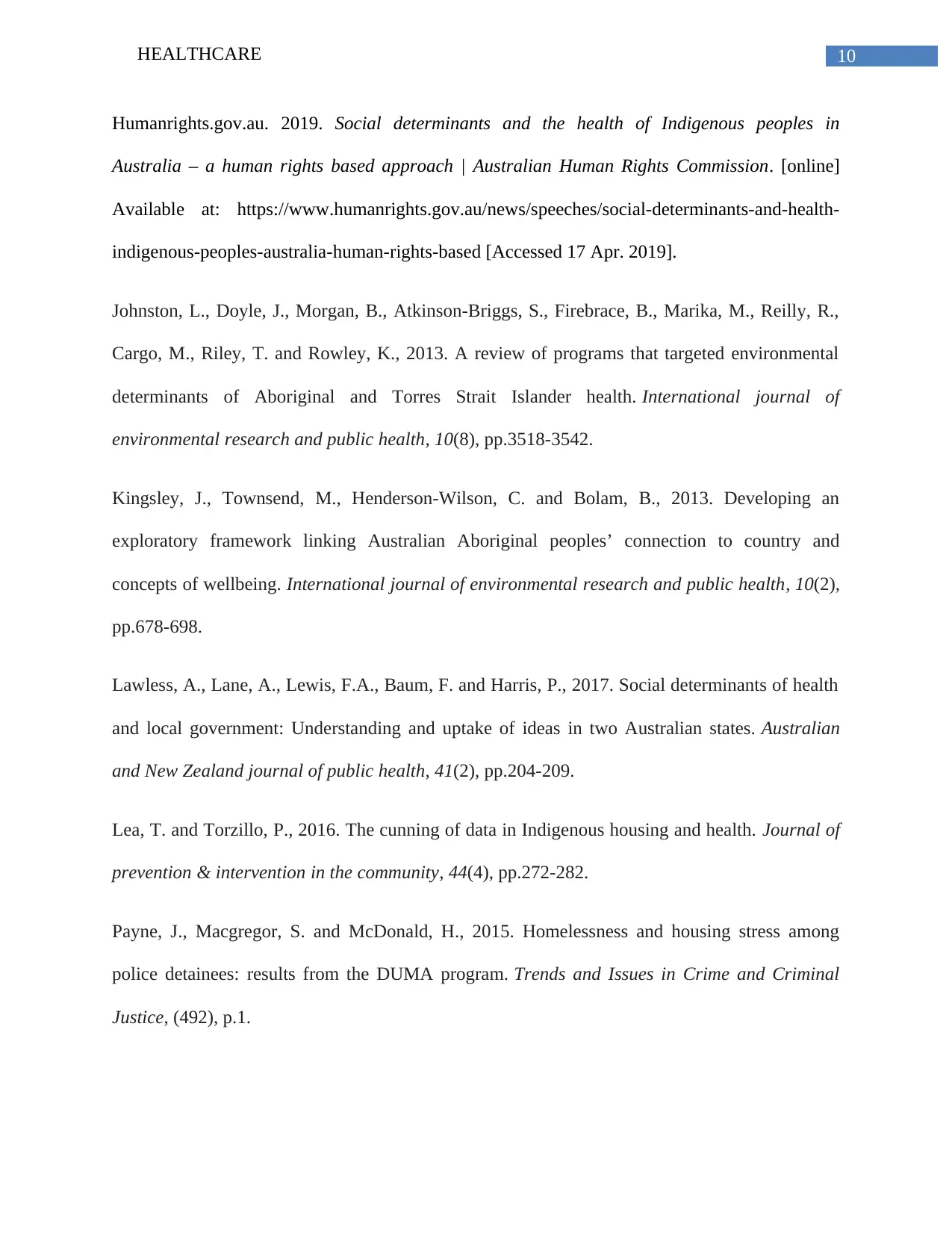
10HEALTHCARE
Humanrights.gov.au. 2019. Social determinants and the health of Indigenous peoples in
Australia – a human rights based approach | Australian Human Rights Commission. [online]
Available at: https://www.humanrights.gov.au/news/speeches/social-determinants-and-health-
indigenous-peoples-australia-human-rights-based [Accessed 17 Apr. 2019].
Johnston, L., Doyle, J., Morgan, B., Atkinson-Briggs, S., Firebrace, B., Marika, M., Reilly, R.,
Cargo, M., Riley, T. and Rowley, K., 2013. A review of programs that targeted environmental
determinants of Aboriginal and Torres Strait Islander health. International journal of
environmental research and public health, 10(8), pp.3518-3542.
Kingsley, J., Townsend, M., Henderson-Wilson, C. and Bolam, B., 2013. Developing an
exploratory framework linking Australian Aboriginal peoples’ connection to country and
concepts of wellbeing. International journal of environmental research and public health, 10(2),
pp.678-698.
Lawless, A., Lane, A., Lewis, F.A., Baum, F. and Harris, P., 2017. Social determinants of health
and local government: Understanding and uptake of ideas in two Australian states. Australian
and New Zealand journal of public health, 41(2), pp.204-209.
Lea, T. and Torzillo, P., 2016. The cunning of data in Indigenous housing and health. Journal of
prevention & intervention in the community, 44(4), pp.272-282.
Payne, J., Macgregor, S. and McDonald, H., 2015. Homelessness and housing stress among
police detainees: results from the DUMA program. Trends and Issues in Crime and Criminal
Justice, (492), p.1.
Humanrights.gov.au. 2019. Social determinants and the health of Indigenous peoples in
Australia – a human rights based approach | Australian Human Rights Commission. [online]
Available at: https://www.humanrights.gov.au/news/speeches/social-determinants-and-health-
indigenous-peoples-australia-human-rights-based [Accessed 17 Apr. 2019].
Johnston, L., Doyle, J., Morgan, B., Atkinson-Briggs, S., Firebrace, B., Marika, M., Reilly, R.,
Cargo, M., Riley, T. and Rowley, K., 2013. A review of programs that targeted environmental
determinants of Aboriginal and Torres Strait Islander health. International journal of
environmental research and public health, 10(8), pp.3518-3542.
Kingsley, J., Townsend, M., Henderson-Wilson, C. and Bolam, B., 2013. Developing an
exploratory framework linking Australian Aboriginal peoples’ connection to country and
concepts of wellbeing. International journal of environmental research and public health, 10(2),
pp.678-698.
Lawless, A., Lane, A., Lewis, F.A., Baum, F. and Harris, P., 2017. Social determinants of health
and local government: Understanding and uptake of ideas in two Australian states. Australian
and New Zealand journal of public health, 41(2), pp.204-209.
Lea, T. and Torzillo, P., 2016. The cunning of data in Indigenous housing and health. Journal of
prevention & intervention in the community, 44(4), pp.272-282.
Payne, J., Macgregor, S. and McDonald, H., 2015. Homelessness and housing stress among
police detainees: results from the DUMA program. Trends and Issues in Crime and Criminal
Justice, (492), p.1.
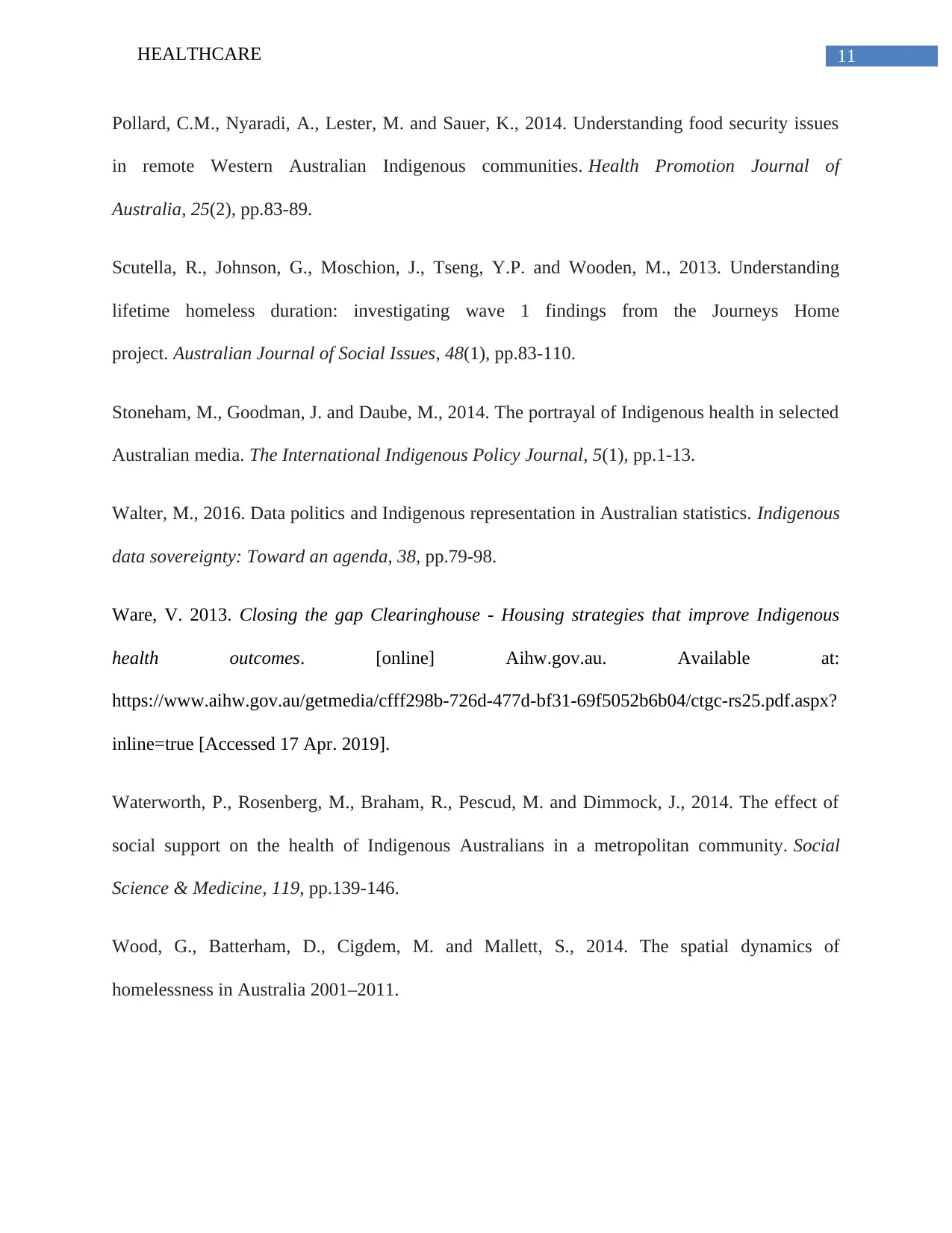
11HEALTHCARE
Pollard, C.M., Nyaradi, A., Lester, M. and Sauer, K., 2014. Understanding food security issues
in remote Western Australian Indigenous communities. Health Promotion Journal of
Australia, 25(2), pp.83-89.
Scutella, R., Johnson, G., Moschion, J., Tseng, Y.P. and Wooden, M., 2013. Understanding
lifetime homeless duration: investigating wave 1 findings from the Journeys Home
project. Australian Journal of Social Issues, 48(1), pp.83-110.
Stoneham, M., Goodman, J. and Daube, M., 2014. The portrayal of Indigenous health in selected
Australian media. The International Indigenous Policy Journal, 5(1), pp.1-13.
Walter, M., 2016. Data politics and Indigenous representation in Australian statistics. Indigenous
data sovereignty: Toward an agenda, 38, pp.79-98.
Ware, V. 2013. Closing the gap Clearinghouse - Housing strategies that improve Indigenous
health outcomes. [online] Aihw.gov.au. Available at:
https://www.aihw.gov.au/getmedia/cfff298b-726d-477d-bf31-69f5052b6b04/ctgc-rs25.pdf.aspx?
inline=true [Accessed 17 Apr. 2019].
Waterworth, P., Rosenberg, M., Braham, R., Pescud, M. and Dimmock, J., 2014. The effect of
social support on the health of Indigenous Australians in a metropolitan community. Social
Science & Medicine, 119, pp.139-146.
Wood, G., Batterham, D., Cigdem, M. and Mallett, S., 2014. The spatial dynamics of
homelessness in Australia 2001–2011.
Pollard, C.M., Nyaradi, A., Lester, M. and Sauer, K., 2014. Understanding food security issues
in remote Western Australian Indigenous communities. Health Promotion Journal of
Australia, 25(2), pp.83-89.
Scutella, R., Johnson, G., Moschion, J., Tseng, Y.P. and Wooden, M., 2013. Understanding
lifetime homeless duration: investigating wave 1 findings from the Journeys Home
project. Australian Journal of Social Issues, 48(1), pp.83-110.
Stoneham, M., Goodman, J. and Daube, M., 2014. The portrayal of Indigenous health in selected
Australian media. The International Indigenous Policy Journal, 5(1), pp.1-13.
Walter, M., 2016. Data politics and Indigenous representation in Australian statistics. Indigenous
data sovereignty: Toward an agenda, 38, pp.79-98.
Ware, V. 2013. Closing the gap Clearinghouse - Housing strategies that improve Indigenous
health outcomes. [online] Aihw.gov.au. Available at:
https://www.aihw.gov.au/getmedia/cfff298b-726d-477d-bf31-69f5052b6b04/ctgc-rs25.pdf.aspx?
inline=true [Accessed 17 Apr. 2019].
Waterworth, P., Rosenberg, M., Braham, R., Pescud, M. and Dimmock, J., 2014. The effect of
social support on the health of Indigenous Australians in a metropolitan community. Social
Science & Medicine, 119, pp.139-146.
Wood, G., Batterham, D., Cigdem, M. and Mallett, S., 2014. The spatial dynamics of
homelessness in Australia 2001–2011.
⊘ This is a preview!⊘
Do you want full access?
Subscribe today to unlock all pages.

Trusted by 1+ million students worldwide
1 out of 12
Related Documents
Your All-in-One AI-Powered Toolkit for Academic Success.
+13062052269
info@desklib.com
Available 24*7 on WhatsApp / Email
![[object Object]](/_next/static/media/star-bottom.7253800d.svg)
Unlock your academic potential
Copyright © 2020–2025 A2Z Services. All Rights Reserved. Developed and managed by ZUCOL.




